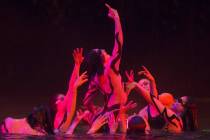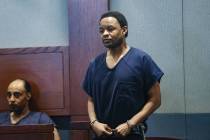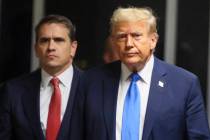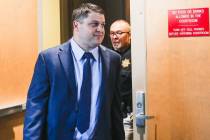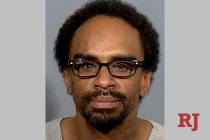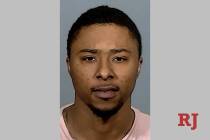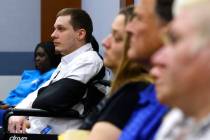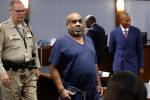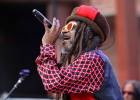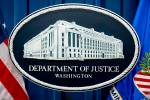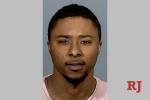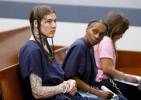FBI outlines parallels in Notorious B.I.G., Tupac slayings
Recently released FBI files dealing with the unsolved 1997 slaying of rapper Notorious B.I.G. don't make any definitive conclusions, but they do provide ammunition for conspiracy buffs who long have suspected the slaying was linked to rival rapper Tupac Shakur's unsolved slaying in Las Vegas.
The two-year FBI probe covered by the documents started out as a review of civil rights violations and public corruption that ended in 2005. At the heart of the federal investigation was whether corrupt Los Angeles police officers were involved in the March 9, 1997, slaying of B.I.G., whose birth name was Christopher Wallace.
The highly redacted 359-page document was released March 27 on the agency's website, a common site to post records that are the subject of several Freedom of Information Act requests. The files attracted little attention until Wednesday.
B.I.G. and Shakur remain two of rap's most successful artists of all time, both having sold tens of millions of albums worldwide.
FBI agents concluded that there wasn't enough evidence to pursue charges against suspected rogue police officers, whose names were redacted from the report, or a man implicated in the B.I.G. slaying. However, the documents do outline ties between the shooting of B.I.G. in Los Angeles and the slaying of Shakur, in similar circumstances, near the Strip six months earlier, on Sept. 7, 1996.
In their reports, FBI agents investigated several motives for the B.I.G. killing, including retaliation for Shakur's slaying.
Agents also describe searching the home of a person, whose name was redacted, as part of the investigation into B.I.G.'s slaying. In the man's garage they found what they described as "a shrine'' to Shakur, with various 9 mm guns, police radio scanners and radios belonging to the Los Angeles Police Department.
B.I.G.'s killer used a 9 mm, but that is a common caliber for semiautomatic pistols.
Investigators also noted that Shakur was owed millions of dollars by a person whose name was redacted and that he was going to leave his record label, Death Row Records, with all his unreleased music.
Shakur was shot at the intersection of Flamingo Road and Koval Lane as he rode in the front seat of a car driven by Death Row Records Chairman Marion "Suge" Knight. Before the shooting, the two had attended the Mike Tyson-Bruce Seldon boxing match at the MGM Grand, where Shakur and his entourage became involved in an altercation with a man named Orlando Anderson of Compton, Calif.
According to police reports, one of the occupants of a nearby vehicle leaned out and fired several shots at Knight's BMW. Shakur, 25, was struck four times and died six days later at University Medical Center, while Knight suffered a minor head wound.
The motives for the Shakur shooting and the later slaying of B.I.G. have been a matter of speculation ever since. Theories involving bad blood between competitive East and West Coast rappers, gang affiliations, artistic and business disputes and a lover's triangle involving B.I.G.'s wife have all become part of urban mythology.
Las Vegas police Lt. Lew Roberts said Wednesday night that investigators continue to pursue Shakur's killer or killers more than a decade later.
"The Tupac case is still open and actively being worked," he said. "We continue to follow leads and hope to solve it one day."
In September 1997, Las Vegas police Sgt. Kevin Manning told the Review-Journal that Shakur's slaying was not motivated by a gang war or arguments within the rap world.
"It appears to be motivated by a personal dispute, more than anything," Manning said.
Police at the time said they think Shakur's associates knew who killed him, but police couldn't make the case.
"We have no witnesses willing to cooperate or any direct evidence implicating any specific individual," Manning said.
Shakur and B.I.G. were arguably the two biggest rap stars in the world before their deaths.
Once friends, they were involved in an ongoing feud between their record labels. B.I.G. was signed to Bad Boy Records, based in New York.
B.I.G. was gunned down outside the Petersen Automotive Museum in Los Angeles as he was seen leaving a music industry party. He was in the middle of a three-car caravan when a dark-colored Chevrolet Impala pulled next to the caravan and an occupant fired several times into the passenger side of the vehicle where B.I.G. was sitting.
The documents show that the FBI examined the link between some LAPD officers who might have been members of street gangs and who worked security for Death Row, and ties between the record label and Blood gang members.
Agents also investigated the possibility that both killings were masterminded by members of Compton's Southside Crips gang. Both Death Row and Bad Boy were known to use gang members as security.
The Associated Press contributed to this report. Contact reporter Antonio Planas at aplanas@review journal.com or 702-383-4638.









